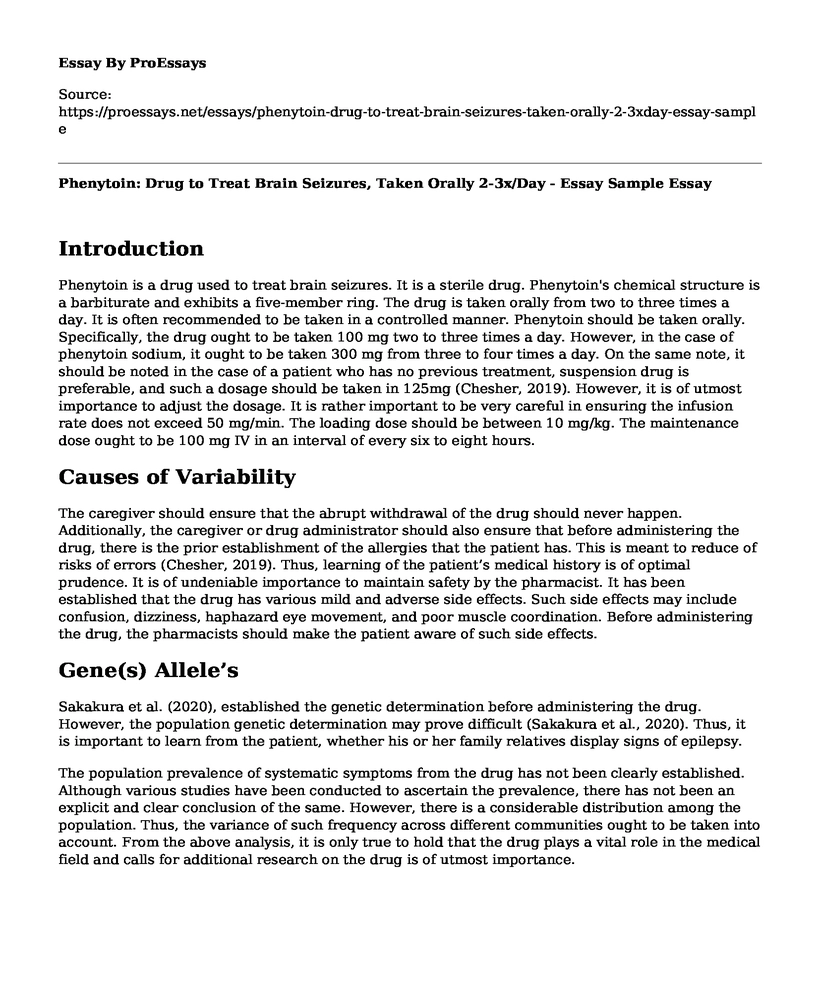Introduction
Phenytoin is a drug used to treat brain seizures. It is a sterile drug. Phenytoin's chemical structure is a barbiturate and exhibits a five-member ring. The drug is taken orally from two to three times a day. It is often recommended to be taken in a controlled manner. Phenytoin should be taken orally. Specifically, the drug ought to be taken 100 mg two to three times a day. However, in the case of phenytoin sodium, it ought to be taken 300 mg from three to four times a day. On the same note, it should be noted in the case of a patient who has no previous treatment, suspension drug is preferable, and such a dosage should be taken in 125mg (Chesher, 2019). However, it is of utmost importance to adjust the dosage. It is rather important to be very careful in ensuring the infusion rate does not exceed 50 mg/min. The loading dose should be between 10 mg/kg. The maintenance dose ought to be 100 mg IV in an interval of every six to eight hours.
Causes of Variability
The caregiver should ensure that the abrupt withdrawal of the drug should never happen. Additionally, the caregiver or drug administrator should also ensure that before administering the drug, there is the prior establishment of the allergies that the patient has. This is meant to reduce of risks of errors (Chesher, 2019). Thus, learning of the patient’s medical history is of optimal prudence. It is of undeniable importance to maintain safety by the pharmacist. It has been established that the drug has various mild and adverse side effects. Such side effects may include confusion, dizziness, haphazard eye movement, and poor muscle coordination. Before administering the drug, the pharmacists should make the patient aware of such side effects.
Gene(s) Allele’s
Sakakura et al. (2020), established the genetic determination before administering the drug. However, the population genetic determination may prove difficult (Sakakura et al., 2020). Thus, it is important to learn from the patient, whether his or her family relatives display signs of epilepsy.
The population prevalence of systematic symptoms from the drug has not been clearly established. Although various studies have been conducted to ascertain the prevalence, there has not been an explicit and clear conclusion of the same. However, there is a considerable distribution among the population. Thus, the variance of such frequency across different communities ought to be taken into account. From the above analysis, it is only true to hold that the drug plays a vital role in the medical field and calls for additional research on the drug is of utmost importance.
Clinical Application or Implication
In the case of a patient who is already taking phenytoin, there ought to be a careful administration of the drug in top-up doses. Such a dose should not exceed 750 mg. In administration phenytoin, the nurse should ensure that the drug not precise but rather in a yellowish color.
It ought to be noted that the drug has various side effects. In the case of renal or hepatitis impairment, there should be close and careful monitoring. This also calls for a dose reduction for such a patient in a bid to reduce toxicity. Additionally, it is of equal importance to have pharmacokinetic considerations. This calls for a careful analysis of therapeutic plasma (Sakakura et al., 2020). In so doing, then dosage increase from initial dosage is done after considering the patient's plasma levels.
Any Clinical Study Done for Dosing-Selection
There has been a previous clinical study done on phenytoin and postoperative epilepsy, which was a double-blinded study. Routine dose administration was 5 to 6 mg/kg/day. This was aimed at high-risk patients (Sakakura et al., 2020). The dosage was started one week post-operatively.
Genetic Testing
Previous studies have shown that there is no explicit need to perform gene testing before administering the drug. This is particularly so because with prior knowledge of the patient’s medical history, then it becomes easy to ascertain the risk levels. Thus, this proves that gene testing becomes of less importance unless for adverse cases.
Patient Case Scenario
Mr. Joseph is a 40-year-old 75kg man who has epilepsy. He receives a 250mg/day dose of phenytoin. However, his seizures have been out of control recently. His plasma level is also reviewed thrice per year and has been recorded as 8.7 mg/l.
References
Chesher, D. (2019). Calculated free phenytoin and albumin adjusted total phenytoin versusmeasured free phenytoin. Pathology, 51, S108.
https://doi.org/10.1016/j.pathol.2018.12.303Sakakura, K., Ishikawa, E., Matsuda, M., Akutsu, H., Masuda, Y., Zaboronok, A., ... & Matsumura, A. (2020). Postoperative epileptic seizures after brain tumorsurgery. Interdisciplinary Neurosurgery, 19, 100549.
https://thejns.org/view/journals/j-neurosurg/58/5/article-p672.xml
Cite this page
Phenytoin: Drug to Treat Brain Seizures, Taken Orally 2-3x/Day - Essay Sample. (2023, Aug 14). Retrieved from https://proessays.net/essays/phenytoin-drug-to-treat-brain-seizures-taken-orally-2-3xday-essay-sample
If you are the original author of this essay and no longer wish to have it published on the ProEssays website, please click below to request its removal:
- Pharmacology Paper on Asthma Example
- What Are the Health Benefits Associated With the Consumption of Caffeine?
- Research Paper on Wearable Tech History and Its Impact on Healthcare
- Fact Sheet on Health Care Insurance Plans - Paper Example
- Research Paper on Ethics in ICU Nursing: Balancing Autonomy and Vulnerability
- Quarantine: An Essential Tool to Combat Contagious Diseases - Essay Sample
- Essay Example on Nursing: Patient Positioning for Physiological Safety







